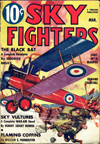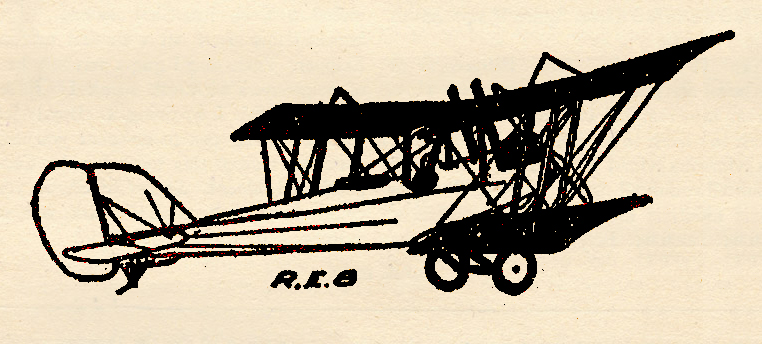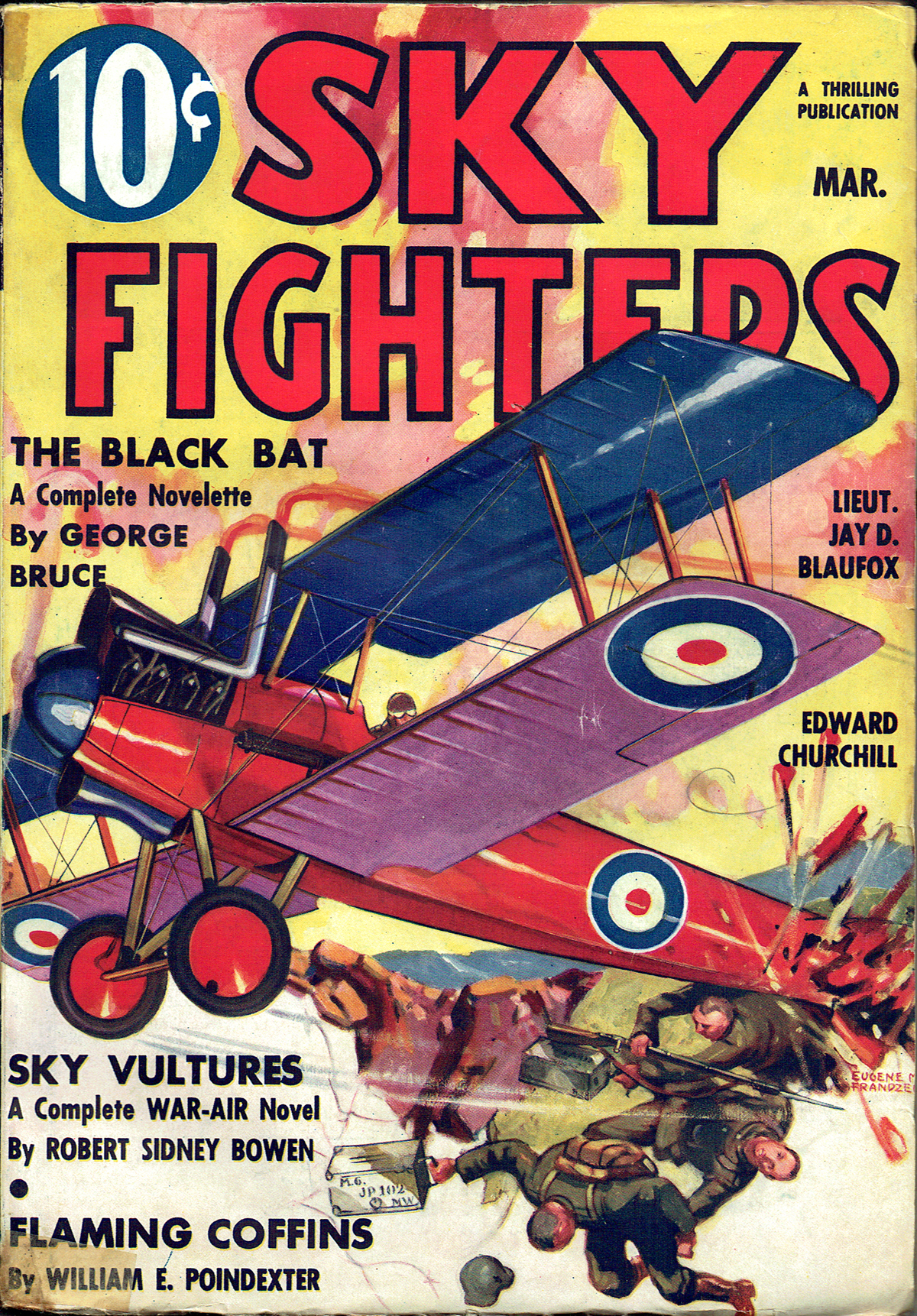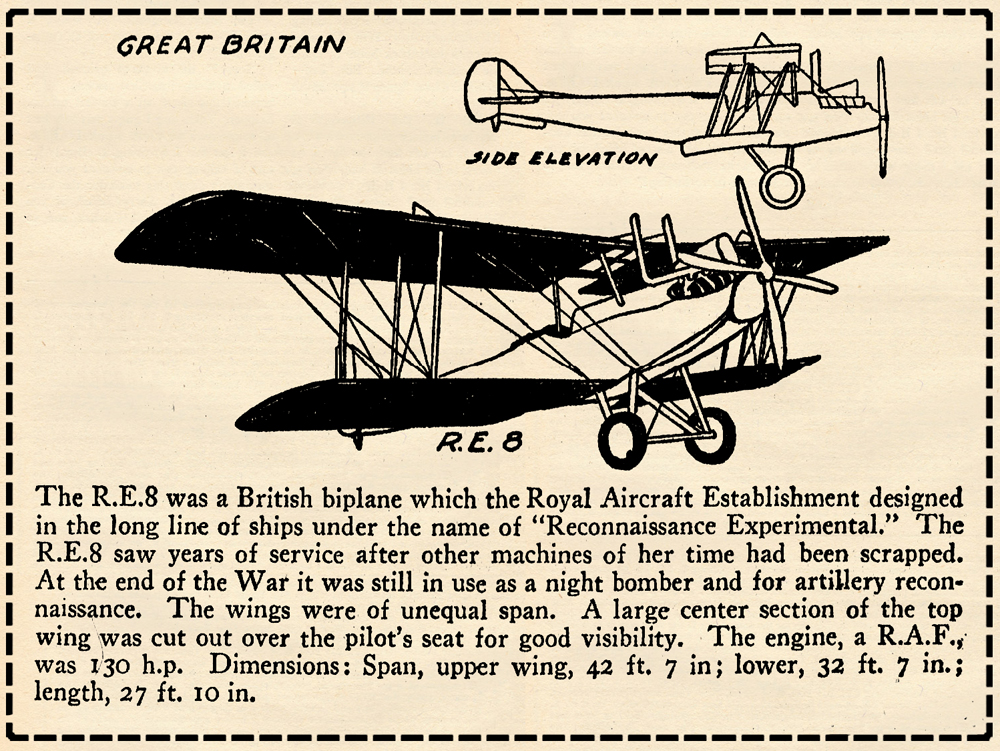“Sky Fighters, March 1936″ by Eugene M. Frandzen
Eugene M. Frandzen painted the covers of Sky Fighters from its first issue in 1932 until he moved on from the pulps in 1939. At this point in the run, the covers were about the planes featured on the cover more than the story depicted. Mr. Frandzen features a battle between a De Haviland Pusher and a German D.F.W. C4 on the March 1936 cover!
The Ships on the Cover
THE R.E.8 had the title  “Reconnaissance Experimental” but there was not so much experimental in her as good old fighting spirit. Since the line of R.E.s preceding the 8 had worked out most of the defects in actual combat flying rather than in the brain of designers, the old girl had been pretty well refined when she made her debut. The British Royal Aircraft Factory was responsible for some lesser lights in their production but the S.E.5 came out on their wartime stage to end the show in a round of applause from the aviators who flew them. But even when the S.E.s were starring at the front the R.E.8s were holding up their end of the show patrolling the sky lanes dropping bombs In the darkness of night to the end of the war.
“Reconnaissance Experimental” but there was not so much experimental in her as good old fighting spirit. Since the line of R.E.s preceding the 8 had worked out most of the defects in actual combat flying rather than in the brain of designers, the old girl had been pretty well refined when she made her debut. The British Royal Aircraft Factory was responsible for some lesser lights in their production but the S.E.5 came out on their wartime stage to end the show in a round of applause from the aviators who flew them. But even when the S.E.s were starring at the front the R.E.8s were holding up their end of the show patrolling the sky lanes dropping bombs In the darkness of night to the end of the war.
Backstage at the training schools the R.E. put the young novices through the groundwork, in this case groundwork of the sky of fancy turns, pauses for leveling out between steep dives, pirouettes, all maneuvers to make sky hoofers for the chorus of war.
Never a Has Been
The R.E.8 did her work so well carrying on in any job that she could never have the slurring title of “Has been.” A ship that could look back on the glories of such a career need never slink away when the applause was for newcomers. It had the quiet reserve to serve gracefully, giving of its experience while treasuring in the heart of its big engine the memory of such days as the one when it flew back in 1918, the scene pictured on the cover.

An army is said to march on its belly. That’s a good old bromide and gets past first base, but marching never brought in a home run. The same can be said for a plane with only gas to feed it. It can go places but it can’t do things. The one thing needed above all others to ground or air forces is ammunition.
Silencing a pair of machine-guns in a bombproof hillside dugout commanding a pass was the problem confronting “Crackup” Jones of Texas and points West. Now “Crackup” came by his name because he had smashed more planes in landing and taking off than any other three living flyers in the A.E.F. He’d cracked his way through two schools and left a trail of splinters that ran up the national debt considerably. But that didn’t bother Mr. Jones for he and every one else who had seen him fly knew that once he got into the air no other two-legged mortal could swap lead with him and live to tell the story.
Wotta Man!
One guy swore he’d seen Jones crack a Nieuport full speed into a hangar roof. Thrown clear he sailed through the air a hundred feet and landed gracefully on the top of a grounded captive balloon. When they finally got him down he’d written a thousand-word account of the experience with diagrams for the “Stars and Stripes.” Wotta man!
“Crackup” is in the pilot’s pit of the old R.E.8 he borrowed from the British. He’d dropped all his bombs on the bombproof dugout at the head of a narrow pass just in front of his own lines. He’d sprayed every round from his machine-guns. His gas was nearly exhausted when he spied three Boche lugging up ammunition to the machine-gun nest. If those men got their cargo to the guns safely it meant the Yanks couldn’t push through.
“Crackup” Thinks—and Acts
“Crackup” thought fast. A narrow river was below the cliff. If he could smash his plane into those Germans and his luck held out he’d be catapulted into the water safe on the Allied side. Having thought, “Crackup” acted. Down he swooped, gave the last drop of gas to his coughing engine and smacked his enemies and their dangerous ammunition over the edge of the cliff with his empennage.
His tailless plane leaped through the air like a ski jumper, cleared the river and smashed head on into a jagged mass of rocks. “Crackup’s” luck had deserted him at last. When they pulled him out of the wreckage it was found that the wind had been knocked completely out of him and he had suffered a severe fracture of the left little finger.

Sky Fighters, March 1936 by Eugene M. Frandzen
(The Ships on The Cover Page)
Full specifications of the R.E.8 were featured in the LIBRARY OF WAR PLANES in this issue.





